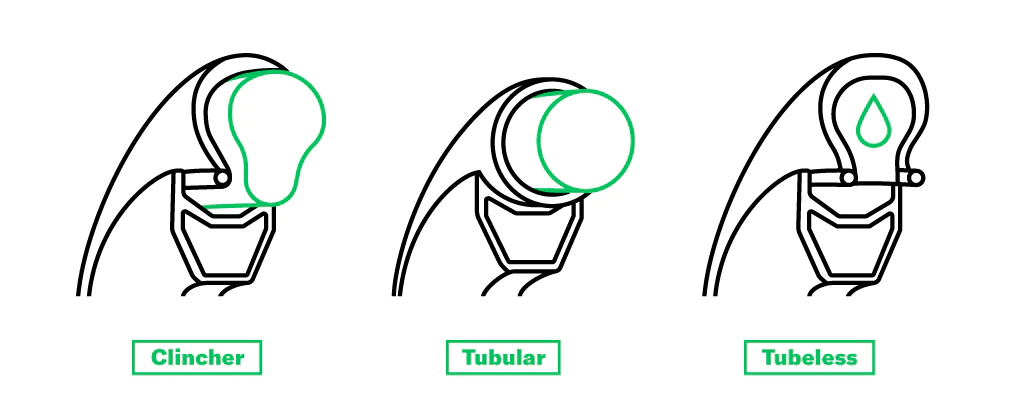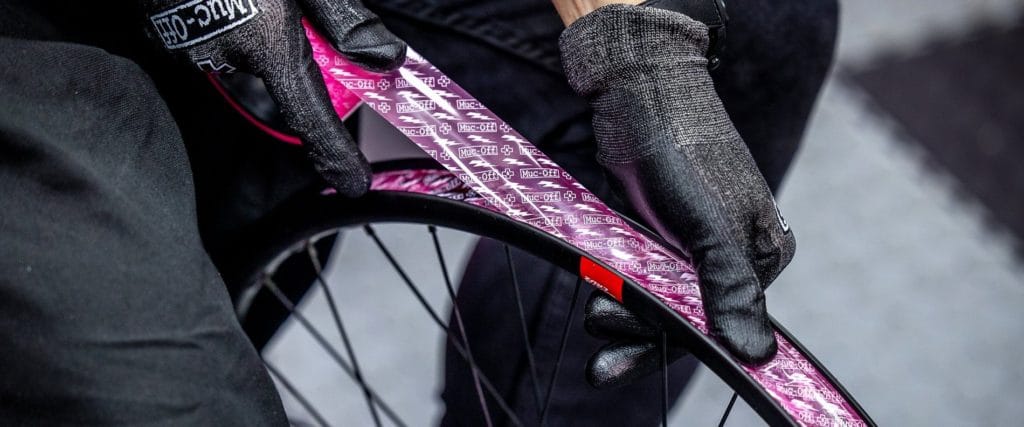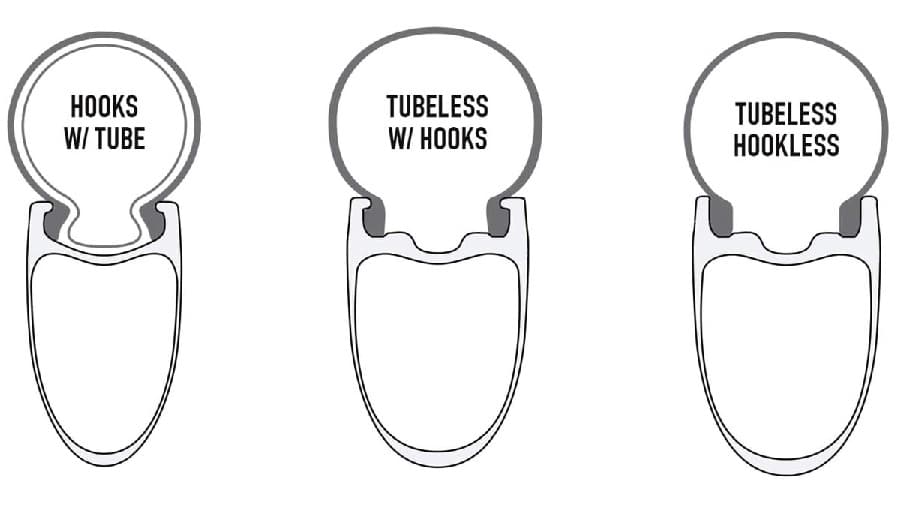If you've clicked here, you're probably a road/gravel rider, right? Maybe you're a mountain biker wondering why roadies are still talking about tube vs tubeless bike tires? Or maybe cycling is a new hobby for you and you're wondering what all the hubbub is about on tubeless bike tire set ups - labels like 'tubeless ready', or products like tire sealant, tubeless valves, and fancy rim tapes?
Regardless, there's good news - it's a well-worn path - cars have been using tubeless tires since the 1950s and, even in cycling, mountain bike tubeless systems have been around (and used) for 20+ years. We've done the research for you to ensure you're ready to take the plunge to jettison your inner tubes or opt out and stick to ye ole faithful inner tube a while longer.
So, why all the noise recently? Our opinion: Cyclists are rediscovering the joy of just riding a bike, and that means gravel, dirt roads, and off-road forays into the unknown - which means wider tires and a desire for more comfort. Even if you're a die hard, race the clock and your mates, 'only the most aero jersey will do' roadie, modern thinking (and research) around aerodynamic profiles, rolling resistance, and pressure of various tire widths and configurations might suggest you've been barking up the wrong tree for... well, ever.
Not to worry, we're going to delve into every aspect of going with tubeless bike tires so you can decide if they're right for you.
It's topical: Jumbo-Visma opted to switch to tubeless bike tires at the 2022 Tour de France for the stage 5 cobbles following wheel collapse incidents. It seems the team was keen to avoid a repeat of the Paris-Roubaix incidents during which two tubular wheels collapsed as a result of punctures.
Luckily for these riders, they simply need to keep riding until the team car arrives to relieve them of the damaged wheel/tire (the rest of us are not so lucky). Evidently, these pros trust in tubeless bike tires enough to ride them when the stakes are as high as they are. This is newsworthy considering the traditionally-stodgy approach of the pro peloton is one reason the adoption of road tubeless bike tires has been slow.
We know it seems self-explanatory, but understanding why bike tires have traditionally used inner tubes to hold air may help explain the added complexity of tubeless bike tires. Maybe you've wondered why you don't have inner tubes in your car tires? Well, go back far enough and your car would have had inner tubes, too. In fact, the tubeless tire wasn't invented until 1947 (in response to high fuel prices... sound familiar?), but was quickly adopted thereafter. So, why didn't bikes follow suit soon after? The challenge is the spoked wheel. Early cars also used spoked wheels and the problem with spokes is that it makes an airtight seal rather difficult to achieve.
We still have spoked wheels on our bikes, so why are we seeing a push towards tubeless bike tires now? Rim, tire, and adhesive fabrication/technology have come a long way to make it all possible. But first, a little bit of background.

Traditional clincher designs use the inner tube as the internal air seal and, once inflated, small hooks on the inside of the rim and outside of the tire bead hold the tire in place. The system isn't intended to be airtight and there is tolerance for imperfections because the tube holds the air, not the tire. The main benefit here is the simplicity of setting it up and the low maintenance with little knowledge required to change a flat mid-ride.
Tubular designs, which are still fairly prevalent in the road pro peloton, are glued to the rim, and the tube is effectively sewn into the tire itself. The main benefit is low weight and the fact that flats tend to lose pressure slowly, while being semi-rideable. Unfortunately, when they do go, they are a bit of a handful to change. If you happen to have someone driving around behind you with spare wheels, this might still be a great option for you... For most riders, the hassle of gluing the tire to the wheel and utter fear of being forced to change a flat out on the road is enough to look for the nearest clincher or tubeless system.
Tubeless bike tires work by completely sealing the tire and rim combination to be airtight, and rely on specifically-crafted rims and tire beads with the assistance of high quality rim tapes and specifically-designed tubeless valves to maintain pressure. The air pressure itself is what keeps the tubeless bike tire on the rim.

Pure tubeless rims are designed to have a separate channel where the spokes enter, producing a smooth airtight surface for the tire. The spoke nipples are then fished through the valve hole, one at a time, with the help of a magnet to build the wheel. Tubeless rims don't require rim tape.
Tubeless-ready rims, on the other hand, look more like a traditional spoked wheel with spoke holes along the center channel. The holes are covered with sticky (non-tubeless rim tape isn't always sticky) tubeless rim tape to ensure that an airtight seal is created.
Both tubeless and tubeless-ready rims require the use of a tubeless-ready tire. Tubeless-ready tires have a specially-designed, typically carbon, bead that won't stretch to the same degree as traditional tires. Obviously, the tire needs to stay rigidly fixed to the rim at all times; otherwise, the air will escape (this is called 'burping'), and your tubeless bike tire will just be a flat tire.
As an added bit of complexity, tubeless bike tires benefit from tubeless sealant injected or poured into the tire to help with the sealing process. In practice, you can often get away without it, but it does help to seal up any punctures that may occur, and it slows the air loss process, which is faster in tubeless than in a traditional tube set up.
In the list of tubeless bike tires pros and cons the first, most obvious advantage of opting for tubeless tires is decreasing the odds of getting a flat mid-ride. If a puncture does occur, that sealant you injected inside the tire will typically seal the hole, which means you can continue to ride even after a puncture. In fact, most often, you won't even know that a puncture occurred as many sealants on the market can seal holes up to 6-7mm in diameter and it happens virtually instantly. That's pretty impressive as a hole that large would cause instant air loss in a tubed tired. We've all been running tubeless bike tires at NOMAD for some time - and the lack of flats is astonishing.
If the hole is too large and you suffer a flat in spite of your (well maintained?) sealant, you can simply insert a tube to get you through the rest of your ride.
Not only do tubeless bike tires experience fewer punctures, but going tubeless means you can ride with a lower tire pressure without fear of the dreaded pinch flat. What's more, lower tire pressure is the best way to absorb surface shocks and make your ride feel more compliant, particularly on rough terrain.
We know, we know: Conventional wisdom would suggest that lower tire pressures mean lower speed, but comfort on long rides means less fatigue and less fatigue eventually translates into more power to the pedals. Plus, lower pressures on rough terrain mean better cornering grip so you can carve it up without the white knuckles.
But, lower pressure means more rolling resistance, right? Well, not exactly. Certainly, riding around on a flat isn't fast, but gone are the days of pumping your tires to the maximum pressure on the sidewall as you want your tire to stay glued to the riding surface rather than jumping up and down and generating a harsh, fatiguing ride.
Modern thinking suggests more rubber in contact with the road will produce a faster overall ride. This is a slightly complicated topic best saved for a future blog on tire widths and pressures, but the take-away here is this: Optimal tire pressure for comfort and speed varies with the terrain and tubeless bike tires provide a much wider operating window.
An additional speed advantage of tubeless bike tires? Friction between the tube and tire is eliminated, which makes a tubeless set up roll faster. This is analogous to the benefits of using latex tubes. Yes, often latex tubes are used for weight savings, but they are also more supple and stretchy than butyl tubes, which means less rolling resistance as the tire/tube combination maintains a better connection and flexes as a unit to absorb road imperfections rather than bouncing over them.
We are often asked whether tubeless bike tire set ups are lighter than traditional tubed tires. We've been witness to some spirited debates of reductions in rotational mass (always considered the worst kind of added weight in cycling) as reason enough to make the switch. Unfortunately, it's not as simple as subtracting the weight of the tube.
Typically, tubeless bike tires weigh slightly more than a traditional clincher tire because they are built to be more robust with a stronger bead to ensure air doesn't leak. Additionally, the use of tubeless sealant is recommended, which adds a few more grams per wheel. In our experience, when you add it all up, a properly provisioned tubeless bike tire will come out about the same as a tire and tube combination.
So why have we flagged this as an advantage? While the tire itself isn't lighter, the rim might be. The rise of tubeless bike tires is giving rise to new methods of manufacturing wheels, specifically greater adoption of hookless rim profiles.
Traditional rims have a small hook around the inside of the rim, which helps to hold the tire in place and ensures it doesn't blow off the rim, particularly under the high pressures used in road cycling. But now, tires are getting wider for comfort (and speed), less pressure is required with wider tires, and tubeless bike tires are more robust to prevent air burping. The net result? Hookless rims found on cars and mountain bikes are on the rise in road and gravel.

Hookless rims use less material (typically carbon), which means less rotational weight where the rim meets the tire. The weight savings of a hookless rim can be relatively substantial while also reducing the cost of manufacturing. But a word of caution: Not all road and gravel tires are compatible with hookless rims so be sure to read the specs of your chosen combination carefully.
In addition to the benefits of improved handling from appropriate air pressures, a properly-maintained tubeless set up can be safer considering it is designed to seal itself in the event of a puncture (punctures that don't self-seal are easy to fix with a tire plug). Anyone who has experienced a sudden flat when riding at high speed can attest to the horrifying feeling of losing control of your bike as you're staring down a steep descent. Technically this is an advantage of fewer flats, but we're always happy to pump up (pun intended!) safety enhancements.
That's a whole lot of upside. But what about the disadvantages of tubeless?
Well, for one, tubeless-ready tires and wheels typically cost more. At least at the moment, tubeless bike tires are a bit more expensive and you have the added cost of tubeless sealant. You will save on tubes and replacement tubes, but - on the whole - tubeless is slightly more costly. In addition, the one-time transition from tubed to tubeless can carry a significant price tag, particularly if you need to replace your wheels.
To get started, you need a tubeless ready (TLR) wheelset and tires, which is an investment. You don't need to rush out to do this, but if you’re planning to splurge on a new bike, watch out for models that come equipped with tubeless ready wheels.
For those nasty tears or holes that are just too large for your tubeless repair kit, you may still need a spare tube to get you the rest of the way. That means, you might still find yourself relying on tubes and almost certainly still carrying one around with you (even if you are going tubeless).
While tubeless set ups may generally be easier to manage, they do require a bit more ongoing maintenance. In particular, air tends to escape faster in tubeless bike tires than in a traditional tube set up, which leaves you topping off your pressures before most rides (even with tubes, you should check your pressures regularly).
Moreover, sealant can escape if the tire bead comes away from the rim owing to a sudden impact, and sealants that coagulate need topping up every six months or so. Even without incident, the sealant seeps through the tire and evaporates over time. The maintenance is all quite simple and in the wheelhouse of any home mechanic, but it's slightly messier than a simple inner tube that you forget about until you have a flat.
The short of it is: It depends. The decision of tubeless vs tube bike tires typically comes down to two major considerations: What terrain you typically ride on, and what your budget is.
Tubeless options will most significantly benefit cyclists who ride off road, but as road tires trend towards wider variants, it's becoming a more natural progression for riding on the road as well. The drastically reduced number of flats is reason enough and you will enjoy less rolling resistance.
Budget is a consideration, but is more about timing. You don't need to rush out and replace your non-tubeless ready wheels just to get rid of your tubes. Most of us aren't racing the Tour de France anytime soon, which means we probably don't need to overinvest in the lightest tires with the lowest rolling resistance (though most of us kind of want to...).
Because we dislike leaving our readers with the 'it depends' response... our take? It's time! We recommend going tubeless for all types of riding, but suggest waiting for the natural time when you're buying a new bike, or investing in a new set of wheels. Already have tubeless ready rims? Then go for it. Here at NOMAD, we've gone tubeless on all of our bikes, and we haven't looked back.
